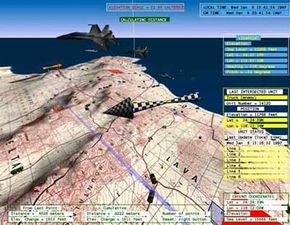Other Applications
Another application of virtual environments in the military is battlefield visualization. Battlefield visualization is vital when determining combat strategies in real time. It's also a key element in the training regimen of commanding officers. It helps commanders assess their options before making decisions that could put soldiers in harm's way.
Tools like Google Earth and SketchUp make creating three-dimensional maps easy and inexpensive. Today, military officials can explore a three-dimensional model of an area, viewing it from any angle while formulating strategies and looking for potential logistical problems.
Advertisement
The military has explored using a VR workbench as a display technology for battlefield visualization. The viewer wears a pair of special goggles that create the illusion of depth, so that the images displayed on the workbench appear to be three dimensional. Multiple users can view the same display at once, assuming they're all wearing the special goggles.
As personal computers and graphics cards become more powerful, the need for specialized display technology decreases. Today, a high-powered laptop can meet much of the military's needs for visualization. The military has found that it can adapt many commercial software and hardware packages for its own needs. You don't get the same level of immersion when working with a personal computer as you would with a dedicated VR system, but the computers are much less expensive and easy to network.
The military also uses virtual environments to prepare soldiers for emergencies. For example, the Navy Research Laboratory has the Virtual Environment Training Technology program. In this program, the Navy trains sailors how to deal with shipboard fires using a virtual environment. The program is still in the validation process, and many Navy officials hope it will allow sailors to train in dangerous techniques in a safe, controlled environment.
To learn more about virtual reality and its applications, check out the links below.
Related Articles
More Great Links
Sources
- Ackerman, Robert K. "Navy Researchers Target, Virtually." Signal. Vol. 60, Iss. 11.
- Alpert, Mark. "My Virtual War." Scientific American.com. January 22, 2006. http://www.sciam.com/article.cfm?articleID=000D0B80-EE81- 13CB-AE8183414B7F0000
- Barrie, Douglas. "Virtual Air War." Aviation Week & Space Technology. New York. May 16, 2005. Vol. 162, Iss 20.
- Beier, K. "Virtual Reality: A Short Introduction." University of Michigan Virtual Reality Laboratory at the College of Engineering.
- Carlson, Wayne. "A Critical History of Computer Graphics and Animation." The Ohio State University. 2003. http://accad.osu.edu/~waynec/history/lesson17.html
- DARPA Tactical Language Training Project. University of Southern California, Micro Analysis & Design, UCLA CRESST, US Military Academy and Eyematic Interfaces.
- Enterprise Solutions Competency Center. "Future Combat System." U.S. Army PEO EIS & Software Engineering Center - Belvoir. http://www.army.mil/escc/ma/war/trans1.htm
- Kramer, Don. "New Simulators Get Stryker Drivers Up to Speed." U.S. Army News. April 27, 2007. http://www.army.mil/-news/2007/04/27/2881-new-simulators-get- stryker-drivers-up-to-speed/
- Macedonia, Michael. "Games, Simulation, and the Military Education Dilemma." Publications from the Forum for the Future of Higher Education. 2002.
- McGrath, Dennis and Carella, Chris. "Synthetic Environments for Emergency Response Simulation." Dartmouth College.
- Pandemic Studios http://www.pandemicstudios.com/
- Peck, Michael. "Soldiers Learn Hazards of War in Virtual Reality." National Defense. February, 2005. http://www.nationaldefensemagazine.org/issues/2005/Feb/UF-Soldiers_ Learn.htm
- Pursell, Robert. "USJFCOM Signs Cooperative Research and Development Agreement with Alion." USJFCOM. March 21, 2007. http://www.jfcom.mil/newslink/storyarchive/2007/pa032007.html
- Quantum3D, inc. "Quantum3D expedition fielded by U.S. Army for Virtual Squad Training System (VSTS) initial deployment at Shofield Barracks, Hawaii. July 10, 2007. http://www.quantum3d.com
- Rock, Aaron. "Virtual environment reinforces real-world skills." Marine Corps News. February 20, 2007.
- Seals, Bob. "The Virtual Battlefield." Special Warfare. Sep/Oct 2006. Vol. 19, No. 5.
- Tate, David, et al. "Virtual Environments for Shipboard Firefighting Training." Naval Research Laboratory.
- U.S. Army News Release. "Future Combat Systems (FCS) Mobile Demonstration Trailer and Technologies Display." May 7, 2007. http://www.army.mil/-newsreleases/2007/05/07/3009-future-combat- systems-fcs-mobile-demonstration-trailer-and-technologies-display/
- U.S. Army. "Virtual Army Experience." http://www.army.mil/
- United States Naval Institute. "Simulation training Today." United States Naval Institute Proceedings. December, 2005. Vol 131, Issue 12.
- Vargas, Jose Antonio. "Virtual Reality Prepares Soldiers for Real War." Washington Post. February 14, 2006. http://www.washingtonpost.com/wp-dyn/content/article/2006/02/13/ AR2006021302437.html
